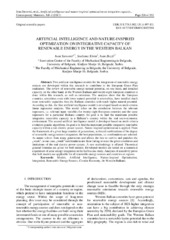Prikaz osnovnih podataka o dokumentu
Artificial Intelligence and Nature-Inspired Optimization on Integrative Capacity ff Renewable Energy in the Western Balkan
| dc.creator | Stevović, Ivan | |
| dc.creator | Kirin, Snežana | |
| dc.creator | Božić, Ivan | |
| dc.date.accessioned | 2023-03-16T09:09:10Z | |
| dc.date.available | 2023-03-16T09:09:10Z | |
| dc.date.issued | 2021 | |
| dc.identifier.issn | 1986-8669 | |
| dc.identifier.uri | https://doi.org/10.7251/COMEN2102226S | |
| dc.identifier.uri | https://machinery.mas.bg.ac.rs/handle/123456789/6476 | |
| dc.description.abstract | Two artificial intelligence models for the integration of renewable energy sources are developed within this research to contribute to the European Green Plan realization. The review of renewable energy natural potential, on one hand, and installed capacity, on the other hand, in the Western Balkans and twenty-eight European countries is done within this research, as well as emissions. The analyses show that the European countries, sometimes even with lower natural potential in renewables, have installed much more renewable capacities than the Balkans countries with much higher natural potential. According to this, the first artificial intelligence model is developed based on multi-criteria linear regression analysis. This model relies on the correlation between the relevant regressors, i.e. relevant input variables for twenty-eight European countries and the same regressors for a particular Balkans country. Its goal is to find the maximum possible integrative renewable capacity in a Balkans’s country within the real socio-economic environment. The second artificial intelligence model is developed based on multi-criteria evolution genetic algorithms. Its goal is to find the maximum possible integrative renewable capacity within a real electric power system. Nature-inspired optimization is applied. From the framework of a given large number of generations, technical combinations of the degree of renewable energy sources integration, the best populations, i.e. combinations are selected. As nature selects from many generations and allows the best to survive and punishes the „weakˮ, in our case, „weak” combinations are those failing to meet the given conditions and limitations of the real electric power system. A new methodology is offered. Theoretical general formulas are given for both models. Developed models are tested on a numerical experiment of solar energy integration in the Serbia case study. Analyses of sensitivity prove that both models are applicable for all renewable energy sources and countries or regions. | sr |
| dc.language.iso | en | sr |
| dc.publisher | Academy of Sciences and Arts of the Republic of Srpska | sr |
| dc.rights | openAccess | sr |
| dc.rights.uri | https://creativecommons.org/licenses/by-nc/4.0/ | |
| dc.source | Contemporary Materials | sr |
| dc.subject | Models | sr |
| dc.subject | Artificial Intelligence | sr |
| dc.subject | Nature-Inspired Optimization | sr |
| dc.subject | Integration | sr |
| dc.subject | Renewable Energy Sources | sr |
| dc.subject | Circular Economy | sr |
| dc.subject | the Western Balkans | sr |
| dc.title | Artificial Intelligence and Nature-Inspired Optimization on Integrative Capacity ff Renewable Energy in the Western Balkan | sr |
| dc.type | article | sr |
| dc.rights.license | BY-NC | sr |
| dc.citation.epage | 252 | |
| dc.citation.rank | M51 | |
| dc.citation.spage | 226 | |
| dc.citation.volume | XII-2 | |
| dc.identifier.doi | 10.7251/COMEN2102226S | |
| dc.identifier.fulltext | http://machinery.mas.bg.ac.rs/bitstream/id/16278/bitstream_16278.pdf | |
| dc.type.version | publishedVersion | sr |


